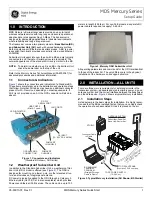
LMT10 0 A N D LMT 20 0 |
M AG N E TOS T R I C T I V E L E V EL T R A N SM I T T ER S | FF O I/L M T 10 0/ 2 0 0/FF - EN R E V. A
19
6 Transmitter wiring
DANGER
Observe all applicable regulations governing electrical
installation Connections must be established only in a zero-
voltage state Since the transmitter does not switch-off
elements, overvoltage protection devices, lightning
protection and / or voltage separation capacity must be
provided at the plant (overvoltage / lightning protection is
optional) Check that the existing operating voltage
corresponds to the voltage indicated on the name plate The
same wires are used for both the power supply and output
signal In case the surge protection option is present and
the transmitter is installed in a hazardous area, the
transmitter has to be supplied power from a voltage source
isolated from mains (galvanic separation) Furthermore, the
potential equalization for the entire powering cable must be
guaranteed since the intrinsic safety circuit of the
transmitter is grounded
Electrical shock can result in death or serious injury Avoid
contact with the leads and terminals High voltage can be
present on leads and cause electrical shock
Do NOT make electrical connections unless the electrical
code designation stamped on the transmitter data plate
agrees with the area classification in which the transmitter
is to be installed Failure to comply with this warning can
result in fire or explosion
Cable connection
Depending on the design supplied, the electrical connection is
established via a cable entry, M20 x 1 5 or ½” NPT thread The
screw terminals are suitable for wire cross sections up to
2 5mm
2
(AWG 14)
IMPORTANT (NOTE)
With transmitters for use in “Zone 2”, a qualified cable gland for
this type of protection must be installed by the customer Refer
to the LMT Series Safety Manual (SM LMT100200-EN A) M20 x
1 5 threads are located in the electronics housing for this
purpose For transmitters with a flame-proof enclosure (Ex db)
type of protection, the housing cover must be secured using the
locking screw The screw plug that may have been supplied with
the transmitter must be sealed at the plant using Molykote DX
The installer assumes responsibility for any other type of
sealing medium used Increased force is required to unscrew
the housing cover after an interval of several weeks This is not
caused by the threads but is due to the type of gasket
CAUTION
• The cable entry device shall comply with the requirements
of EN 60079-0 and maintain IP 54 or better as required by
the installation conditions
• Field wiring should be rated at least 10°C above the device
maximum ambient temperature
1
External ground terminal
2
Internal ground terminal
3
Fieldbus line (polarity independent)
Figure 17 LMT Foundation Fieldbus terminal scheme
Supply requirement
For signal / power connections, use twisted, stranded pairs of
wiring, 18 to 22 AWG / 0 8 to 0 35mm
2
Ø up to 1500m (5,000ft)
Longer loops require lower gauge wire If a shielded wire is
used, the shield should be grounded only at one end, not both
ends In case of wiring at the transmitter end, use the terminal
located inside the housing marked with the appropriate
symbol
The supply voltage range is 9 VDC to 32 VDC
For Exia approval power supply must not exceed 24 VDC (FF -
816 certification) or 17 5 V DC (FISCO certification)
Avoid routing cables with other electrical cables (with inductive
load) or near large electrical equipment
















































